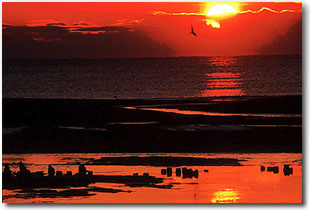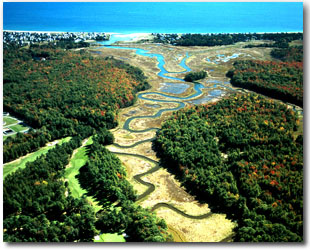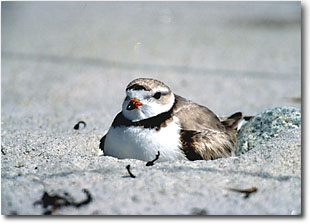|
The Camera Hunter®
Photography and Text Copyright Bill Silliker, Jr.
All rights reserved.
Save The Earth With Your Camera
You don't need to be a professional photographer to make a difference in helping nature. Indeed, the guy with the camera described in the following excerpt from my soon to be published book was anything but a pro. I was shooting with limited equipment, training and capability. In the process, I learned the real power of photography; how to consistently get better photographs; and ultimately, why I was on the planet to begin with. I've since been lucky enough to photograph literally millions of acres of my beloved home state of Maine to help a variety of nature groups and land protection organizations.
 In these times of international troubles, it's important to remember that having a safe world involves more than freedom from terrorism. The entire planet needs the help of those who understand that some natural places are special and should be protected. As nature photographers, we have a unique knowledge and awareness of this concept.
In these times of international troubles, it's important to remember that having a safe world involves more than freedom from terrorism. The entire planet needs the help of those who understand that some natural places are special and should be protected. As nature photographers, we have a unique knowledge and awareness of this concept.
Special places in need of the services of a decent photographer exist everywhere, including my backyard and yours. Some are vast stretches that cover entire ecosystems; others may be only a handful of acres. No matter the size, they can benefit from the nature photographers who use their images to help inspire the protection of the land. Some NPN participants responding to the Forum question concerning magazine content have replied that they'd like to read more on how to help protect nature through their photography. This article will shed some light on that. We nature photographers can help to save the Earth, even if it's one acre at a time.
Excerpted from Vanishing Maine? (Down East Books, Spring 2002, text and photography by Bill Silliker, Jr.) -
"Everyone knows that there's nothing out there but seagulls."
Those few words spoken at a Saco planning board meeting ignited a fire amongst a group of folks who wanted to keep some of southern Maine the way that it was. The year was 1986. Real estate developers had discovered the south coast of Maine as a place to build vacation homes. Proposal after proposal swamped small town planning boards and threatened natural resource areas. None of the communities caught in the sudden storm had laws adequate to protect the resource.
Especially vulnerable were the upland edge and freshwater wetland areas adjacent to south coastal Maine's handful of salt-water estuaries. These special acres provide vital food, cover and breeding habitat for migratory waterfowl, wading birds and songbirds. Many of these acres were on a "wish list" for inclusion in the Rachel Carson National Wildlife Refuge. However, the U.S. Fish and Wildlife Service had no funds with which to purchase them.
One of the largest of the development proposals called for 1,000 dwelling units - condos, year round homes, a convention center and more - a project that would have chewed up some 500 acres of the critical upland buffering the Saco side of the Goosefare Marsh. While the developers had the best of intentions with their plan, they overlooked the fact that the wildlife their lands supported would be severely impacted.
The Goosefare development proposal and smaller projects with similar impacts on other natural areas prompted questions that southern Maine's local governments had never faced before. Questions such as: what were a community's rights regarding control of the cumulative impacts of development on special natural areas? A house here or there made minor impact, but as more landowners exercised individual rights, the collective result was beginning to devastate natural areas. Few communities had enacted zoning and planning laws to deal with such concerns, perhaps because most Maine people share not only a penchant for independent thinking, but also a dislike for governmental interference in their affairs.
 As one who was very familiar with the Goosefare Marsh, I was shocked at the size and impact of the plan. I had swam in the Goosefare Brook, hiked its upland woods trails and enjoyed watching a variety of wildlife use its resources. Now, I set out to capture some of the magic of the Goosefare Marsh on film. It was when showing some of those photographs to a neighborhood gathering that I really understood the power of photography.
As one who was very familiar with the Goosefare Marsh, I was shocked at the size and impact of the plan. I had swam in the Goosefare Brook, hiked its upland woods trails and enjoyed watching a variety of wildlife use its resources. Now, I set out to capture some of the magic of the Goosefare Marsh on film. It was when showing some of those photographs to a neighborhood gathering that I really understood the power of photography.
That neighborhood group decided to organize as the Saco Citizens Coalition and to research the impacts that the development project might have on the special natural resources of the Goosefare Marsh. Like most of our neighbors, we had thought since a small sign proclaimed it to be part of the Rachel Carson National Wildlife Refuge, the Goosefare was protected from development. We soon found out that only the half-acre parcel that the sign was posted on was protected.
The Citizens Coalition began to make carefully worded statements about the resource values of the Goosefare at local public meetings and to community, state and federal officials, and to the press. With those statements we showed them photographs of the Goosefare Marsh that was at risk. And then we asked: "What about the Rachel Carson Refuge?"
We focused on the positive. The Saco Citizens Coalition's bumper stickers said "Save the Marsh". We weren't out to totally stop the development, but to control it adequately to protect the resource - and to keep some of what was special about Saco from disappearing forever. As with all such land protection efforts, the story is not as simple as space allows for. The developers had sympathy from some in the community, including many in local government who thought their plan offered progress and a boon for the economy.
As the months dragged into years, with meeting after meeting, always with new challenges to face, it often seemed that our efforts were futile. But the perseverance and the consistent message of the Saco Citizens Coalition attracted the attention of a larger, more experienced organization.
In 1989 the Maine Chapter of the Nature Conservancy - which ironically was co-founded by Rachel Carson in the 1950's - borrowed 2.3 million dollars and quietly purchased all the lands intended for that Goosefare development project. It was their largest purchase in Maine to that date. Theirs was a holding action: these lands were hopefully to become part of the Rachel Carson National Wildlife Refuge. This presented The Nature Conservancy with a good deal of risk, as they could only hope that the U.S. Fish and Wildlife Service would have the funds to pay them back. Thanks to an extra effort by some of our members, we got commitments from Maine's entire Congressional delegation that they would do everything that they could to see that happen as soon as possible.
 With the assistance of several unique individuals, including Cherie Mason from the Maine Sierra Club and Andrew French, then refuge manager of the Rachel Carson National Wildlife Refuge, the Saco Citizens Coalition had by then spawned another organization: the Friends of Rachel Carson National Wildlife Refuge.
With the assistance of several unique individuals, including Cherie Mason from the Maine Sierra Club and Andrew French, then refuge manager of the Rachel Carson National Wildlife Refuge, the Saco Citizens Coalition had by then spawned another organization: the Friends of Rachel Carson National Wildlife Refuge.
The Friends of Rachel Carson banded together concerned residents of each of the southern Maine communities from Kittery to Cape Elizabeth that were home to the ten divisions of this far flung refuge. The Friends primary mission has been to see that the Rachel Carson National Wildlife Refuge gets the federal funding and support that it needs to complete the refuge's land acquisition plans. The funds for purchasing these lands are not tax dollars. Instead they come from the Land and Water Conservation Fund, a special fund established by Congress with the revenues from federal oil and gas leases. The Land and Water Conservation Fund was designed by Congress to be used to protect such special natural resource lands.
The Saco Citizens Coalition has long since disbanded, its work done. But the Friends of Rachel Carson National Wildlife Refuge, which the Coalition founded in 1987, continues to this day. It has been a friend of the refuge indeed. When the Friends of Rachel Carson was first organized, Rachel Carson National Wildlife Refuge had received only $650,000 for land acquisition from the Land and Water Conservation Fund. Thanks in part to the efforts of the Friends, the Rachel Carson National Wildlife Refuge has since received over $20 million in land acquisition funding. That money has saved a lot of special acres. And it all started with a guy with a camera.
Catch yours in the good light.
BS-NPN 012
Comments on Bill Silliker, Jr.'s The Camera Hunter articles? Send them to the editor.
Maine wildlife & nature photographer Bill Silliker, Jr. – The Mooseman - photographed at many wild places in North America, with the results published in magazines internationally and in 9 of his own books. Bill was an instructor of wildlife and nature photography for L. L. Bean's Outdoor Discovery Program and a member of the Fuji Film Talent Team. Read more about Bill on the Camera Hunter archives page.


| 


